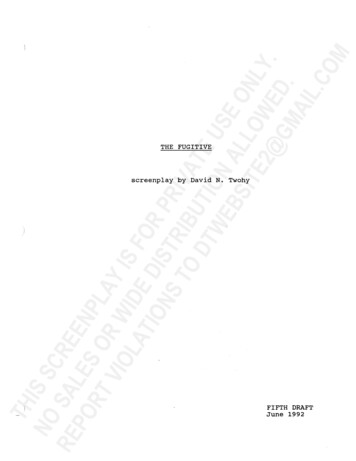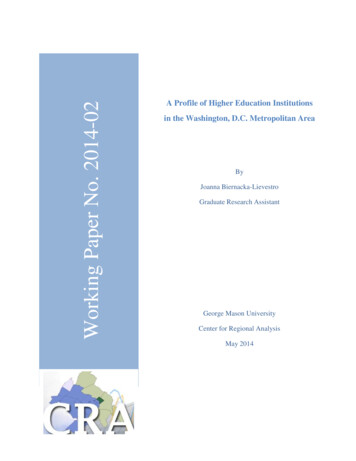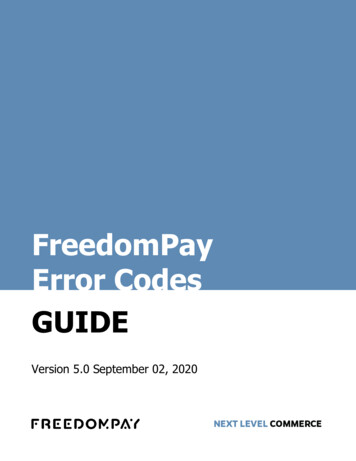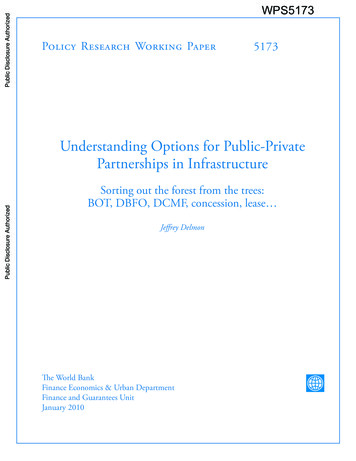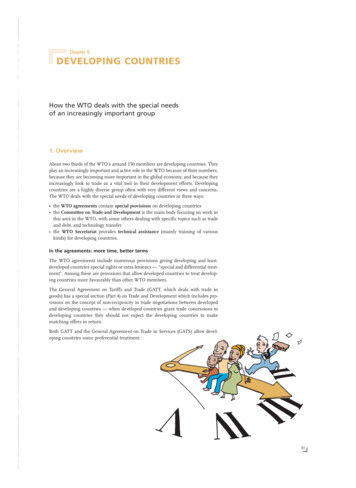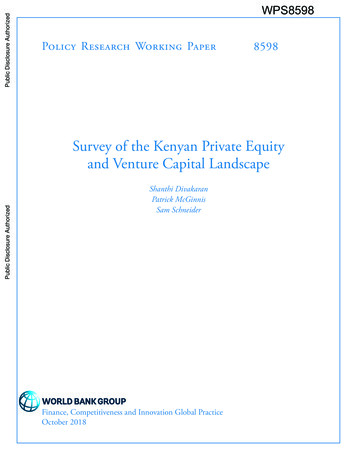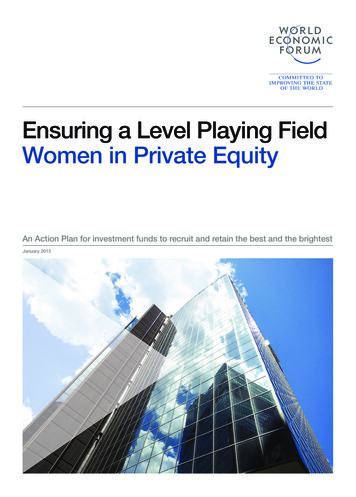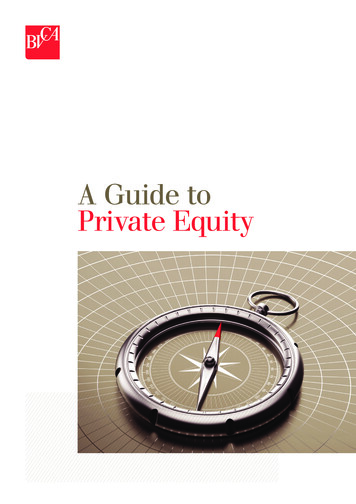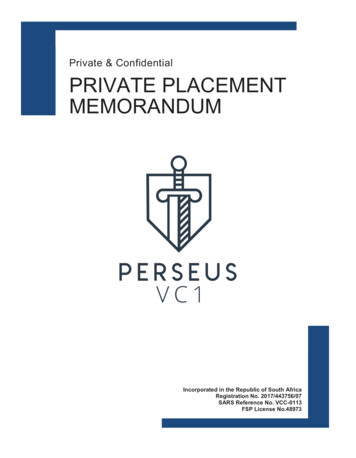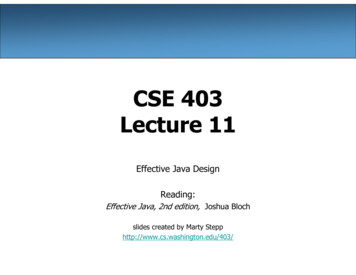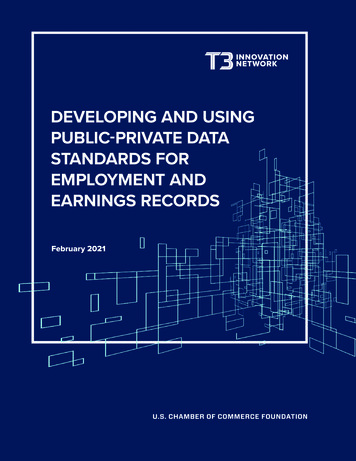
Transcription
DEVELOPING AND USINGPUBLIC-PRIVATE DATASTANDARDS FOREMPLOYMENT ANDEARNINGS RECORDSFebruary 2021
TABLE OF CONTENTSEXECUTIVE SUMMARY 3INTRODUCTION 4SECTION I: PUBLIC-PRIVATE COLLABORATION IN THE DEVELOPMENTAND USE OF DATA STANDARDS FOR EMPLOYMENT AND EARNINGS RECORDS 6SECTION II: T3 NETWORK PROJECT ON EMPLOYMENT AND EARNINGS RECORDS STANDARDS 8SECTION III: HR OPEN WORK GROUP USE CASES, CONCEPTUAL DATA MODEL,AND DATA DICTIONARY 10SECTION IV: BENEFITS, COSTS, AND CHALLENGES IN USING STANDARDSFOR IMPROVING GOVERNMENT REPORTING 13SECTION V: EXPLORING WHERE TO START IN IMPROVING FEDERAL AND STATE DATACOLLECTION 15SECTION VI: SUMMARY AND NEXT STEPS 22ACKNOWLEDGEMENTS 23APPENDIX A: KNOWN FEDERAL AND STATE SYSTEMS IN THE UNITED STATES REQUIRINGEMPLOYERS TO MAINTAIN RECORDS ON EMPLOYMENT, HOURS, AND EARNINGS 24APPENDIX B: EMPLOYMENT AND EARNINGS DATA CURRENTLY COLLECTEDON UNEMPLOYMENT INSURANCE WAGE RECORDS 27APPENDIX C: EMPLOYMENT AND EARNINGS DATA CURRENTLY COLLECTEDBY UNEMPLOYMENT INSURANCE OTHER THAN WAGE RECORDS 30APPENDIX D: EMPLOYEMENT AND EARNINGS DATA DICTIONARY TABLE OF CONTENTS 33APPENDIX E: POTENTIAL BENEFITS AND USES OF ENHANCED UNEMPLOYMENTINSURANCE WAGE RECORDS 39APPENDIX F: POTENTIAL CHALLENGES AND COSTS OF ENHANCED UNEMPLOYMENTINSURANCE WAGE RECORDS 43U.S. CHAMBER OF COMMERCE FOUNDATION T3 INNOVATION NETWORK
EMPLOYMENT AND EARNINGS RECORDSEXECUTIVE SUMMARYThe U.S. Chamber of Commerce Foundation (Chamber Foundation) and the T3 Innovation Network (T3Network) recently partnered with the HR Open Standards Consortium (HR Open) to develop public-privateopen data standards for employment and earnings records. Employers use these records in businessplanning and managing their human resources and report them to federal and state governments,including state Unemployment Insurance (UI) systems. The HR Open standards establish commondefinitions, clarify data relationships, and provide guidance for employers and their human resources (HR)technology service providers on maintaining and reporting the records, and for government agencies onestablishing reporting requirements and data collection systems. This information is provided through aconceptual data model and data dictionary. These standards also provide more technical schema andother documentation to assist in the implementation of the standards. These standards are designedfor use in reducing data reporting costs for employers and government and improving labor marketinformation. The Chamber Foundation and T3 Network also partnered with the National Association ofState Workforce Agencies (NASWA) to assist in engaging states and other stakeholders in developingand reviewing the standards and exploring their applications for enhancing state UI wage records andimproving labor market information.Working with the T3 Network, HR Open developed the standards for employment and earnings recordsbased on employer and government use cases and a comprehensive review of federal governmentreporting requirements, as well as selected state reports, including state UI wage record reporting. Thesestandards also address the major data priorities of states considering expanding or enhancing the UI wagerecords (e.g., occupation, work location, work hours).These standards offer substantial potential benefits to employers, government, and other stakeholders.The standards have the potential to reduce reporting and data collection costs and improve data quality.They also address some of the most critical data needed for improving the labor market information usedby businesses, workers, policy makers, and the general public. However, these potential benefits need tobe weighed against potential implementation issues and costs, including the initial changes in employerhuman resource information systems and reporting systems, government data collection systems, andadditional state administrative costs resulting from the additional data requirements for improving labormarket information.Reducing reporting and data collection costs while improving labor market information can best beachieved by reducing the number of government reports and the variability in government reportingrequirements. One promising starting point for using these HR Open standards would be a collaborativestate approach for enhancing state UI wage records that would reduce variability in state UI reportingrequirements and reduce the need for some federal reporting. Taking this approach, interested stateswould work together with employers and HR technology service providers as well as federal agenciesto further develop and use HR Open standards for establishing common state UI wage record reportingrequirements. States would also develop and use more efficient systems for collecting and sharing databased on these requirements and other public-private standards, collaborate in developing innovativelabor market information products and services for employers and government, and explore data sharingamong federal and state agencies to further reduce overall reporting costs for employment and earningsdata based on enhanced state UI wage records.U.S. CHAMBER OF COMMERCE FOUNDATION T3 INNOVATION NETWORK PAGE 3
EMPLOYMENT AND EARNINGS RECORDSTo be successful, this public-private approach will require strong employer leadership in workingcooperatively with interested states and other public and private stakeholders. As a result, the nextsteps should be for the Chamber Foundation to work with employers, HR Open, HR technologyservice providers, states, federal agencies, and other stakeholders to further explore this approach andimplementation strategies.INTRODUCTIONThe U.S. Chamber of Commerce Foundation (Chamber Foundation) launched the T3 Innovation Network(T3 Network)1 in 2018 to create a public-private data and technology infrastructure that would enable thedigital transformation of the talent marketplace. One major focus of this initiative is improving public-privatecollaboration in the development and use of data standards for a variety of public and private applications.One of several projects the T3 Network established to further these goals is the Employment and EarningsRecords Standards Project.For this project, the T3 Network and the HR Open Standards Consortium2 (HR Open) formed a workinggroup (HR Open Work Group) to develop data standards for employment and earnings records for use byemployers, government, and other stakeholders. These HR Open standards establish common definitions,clarify data relationships, and provide guidance for employers and their human resources (HR) technologyservice providers3 on maintaining and reporting the records, and for government agencies in establishingreporting requirements and data collection systems. This information is provided through conceptual andlogical data models and a data dictionary. These standards also provide more technical schema and otherdocumentation to assist in the implementation of the standards. The HR Open Work Group focused ondeveloping standards that could be used to improve data quality and reduce costs in federal and statedata collection and improve labor market information.The T3 Network also partnered with the National Association of State Workforce Agencies (NASWA) toassist in engaging states and other stakeholders in developing and reviewing the standards, exploringapplications for enhancing state Unemployment Insurance (UI) wage records, and augmenting labor marketinformation.During the first phase of this project, the T3 Network, in cooperation with HR Open, conducted an initialforum to identify leading stakeholder needs and use cases for employment and earnings records includingUI wage records. With this input, the HR Open Work Group developed sample use cases on employerreporting of employment and earnings data to government agencies and how employer-provided datacould be used to improve labor market information and government program management. Based on theinitial use cases, the HR Open Work Group identified employment and earnings data elements that shouldbe considered for standardization. To do so, the group reviewed existing standards, earlier research onstandardization, and 48 federal and state data collection systems that gather employment and earningsdata from employers, including state agency data collection systems for UI wage records. The HR OpenWork Group then developed a set of draft or “candidate” employment and earnings records standards.1The T3 Innovation Network, U.S. Chamber of Commerce Foundation, 2021, 2The HR Open Standards Consortium, 2021, https://www.hropenstandards.org.3HR technology service providers are companies that assist employers by providing technology, web-based applications, andother services to support human resource management and government reporting.U.S. CHAMBER OF COMMERCE FOUNDATION T3 INNOVATION NETWORK PAGE 4
EMPLOYMENT AND EARNINGS RECORDSThe draft standards include a comprehensive data dictionary with over 200 data elements and definitionscrosswalked to one or more federal and state data collection systems along with guidance on theirapplication for government reporting in the United States.The T3 Network project team then partnered with HR Open and NASWA to conduct additional stakeholderforums with employers, HR technology service providers, and federal and state agencies to review thedata dictionary and its potential applications. The stakeholder forums were followed by two deep-divesessions that provided an opportunity for more detailed discussion of the draft standards and the potentialbenefits and costs of their adoption. Additionally, the T3 Network project team and HR Open conductedmeetings and interviews with leading HR technology service providers and state agencies to exploreimplementation goals, issues, costs, and benefits. State agency meetings also addressed issues andopportunities in developing a collaborative state approach for using the standards in UI wage recordenhancement.Based on these activities, the T3 Network project team recommended a proposed public-privatecollaborative approach for enhancing state UI wage records. The project team also proposed next stepsfor further exploring implementation.This report contains six sections: Section I summarizes the need for the T3 Network project; Section IIprovides an overview of the project and its objectives and major work activities; Section III summarizesthe work of the HR Open Work Group, including major use cases, data models, and standards developed;Section IV presents an overview of the types of benefits, costs, and challenges discussed in thestakeholder forums, follow-up meetings and interviews, and previous research projects and reports;Section V explores different approaches and options in using the standards to improve data qualityand reduce costs in government reporting; and Section VI proposes next steps in further exploring theapplication of these standards for enhancing state UI wage records and improving overall federal and statedata collection systems.U.S. CHAMBER OF COMMERCE FOUNDATION T3 INNOVATION NETWORK PAGE 5
EMPLOYMENT AND EARNINGS RECORDSSECTION I: PUBLIC-PRIVATE COLLABORATION IN THEDEVELOPMENT AND USE OF DATA STANDARDS FOREMPLOYMENT AND EARNINGS RECORDSThe availability of high-quality and trustworthy information is essential to the efficient and equitablefunctioning of the talent marketplace in the United States and throughout the world. It is critical for soundeconomic decision making by employers, workers, education and training providers, government, andother intermediaries and service providers. It also supports evidence-based government policy making.Historically, federal and state government agencies have provided free and open access to critical labormarket information including industry and occupational trends and projections as well as occupationalwage and salary information. In recent years, government agencies have begun to provide informationon the employment and earnings outcomes of education and training programs. Federal and stategovernment agencies have developed a large share of this information from data collected directly fromemployers through both administrative reporting systems and surveys. To a great extent these reportsand surveys have been designed to meet specific needs, and are conducted by agencies independentlywithout considering the cumulative effect on employers doing the reporting and the lack of consistencyand comparability in how employer data is used for producing labor market information.One cornerstone of federal and state labor market information is the data on wage records collectedas part of administering state UI programs. The basic UI employer and wage records provide valuableinformation including the industry of employment and earnings of individual workers. These data areuseful for a variety of applications, including the analysis of industry employment trends and dynamics andestimating the labor market outcomes of education and training programs. Some states have augmentedthe basic UI wage record with additional data requirements (e.g., occupation, hours worked, date of hire)to provide enhanced views of state labor market activity and/or improve program administration. Theunderlying collection systems and augmentations have been designed and carried out on a state-by-statebasis, with little thought given to consistency or comparability across states, resulting in a great deal ofvariation in report content and format.In addition to certain data simply not being available in many states, users have questioned the quality,timeliness, and geographic specificity of data that are available. For example, current UI wage recordreporting requirements do not provide consistent work location information. Some employers report acentralized work location for all employees within a state (e.g., company headquarters) while others reportby separate business establishments where employees actually work (e.g., retail store, manufacturingfacility). This inconsistent information prevents consistent analysis of employment by region or local labormarket within a state.Employer survey data cannot easily be used to address the gaps and limitations of employer administrativedata collected through state UI systems. Over many years, changing and conflicting government budgetpriorities have led to reduced funding for labor market statistics. That, in turn, has forced reductions insurvey sample sizes, which has lessened the reliability of data, especially at state and substate levels.U.S. CHAMBER OF COMMERCE FOUNDATION T3 INNOVATION NETWORK PAGE 6
EMPLOYMENT AND EARNINGS RECORDSEfforts to improve government labor market information have called for more states to expand or enhanceemployer reporting requirements on UI wage records.4,5 Users have raised persistent questions aboutoutcomes from education and training programs such as occupational preparedness, work hours, genderequity, and location of work opportunities. At the same, these efforts have raised major concerns amongemployers about increased costs of providing this additional information across more states. This buildson long-standing concerns regarding the variability in report content and format for which employers, ortheir HR technology service providers, must customize their reports. Other users have noted the negativeeffects on data quality and comparability when varying data elements and definitions are used amongstates and the federal government.One potential solution is for employers and their HR technology service providers to work with governmentagencies to take a more coordinated public-private approach to defining and updating data standards andintegrating them into HR software for government reporting. This approach could be applied to UI wagerecord reporting as well as other federal and state government reporting systems and surveys. In addition,employers and their HR technology partners could work with government agencies to establish standardsand approaches for more efficient data collection based on leading data sharing practices among HRtechnology partners.6The United States is unique in having a public-private approach to standards development and use.Federal policy now strongly encourages federal agencies to use public-private voluntary consensusstandards wherever available and applicable in addressing their needs. There are no known equivalentpolicies at the state level and this federal policy to date has seen only limited application to data standards(e.g., electronic health records). In addition, there have been no systematic applications of public-privatevoluntary consensus data standards for employer-provided workforce data, such as UI wage records, tofederal and state agencies.The T3 Network is working with leading standards organizations and government agencies to determinehow this federal policy could provide a starting point in developing a collaborative public-private approachfor data standards development and use for improving the talent marketplace.7 The T3 Network initiativeon public-private data standards provides a unique opportunity to pilot test a new public-private approachfor developing and using data standards for employment and earnings records that could be applied forenhancing UI wage records as well as other federal and state data collection systems. This new publicprivate approach has the potential to expand and enhance UI wage records for labor market informationapplications while at the same time addressing some of the major barriers and issues that have stymied4“Enhancing Unemployment Insurance Wage Records, Potential Benefits, Barriers, and Opportunities—Final Observationsand Recommendations,” Workforce Information Council, September 2015, ns to Improve the Nation’s Workforce and Labor Market Information System,” Workforce Information AdvisoryCouncil, January 2018, fs/WIAC Recommendations Report 2018-01-25Final and Signed.pdf.6For example, leading standards organizations such as HR Open, HR technology service providers, and government agenciescould build on leading public and private practices in the use of application programming interfaces (APIs) in data collection.This could build on the work of federal statistical agencies in collecting data from companies. See Ron S. Jarmin, “EvolvingMeasurement for an Evolving Economy: Thoughts on 21st Century US Economic Statistics,” Journal of Economic Perspectives—Volume 33, Number 1—Winter 2019—Pages 165–184.7“Public-Private Standards Development and Use by Government for the Talent Marketplace,” U.S. Chamber ofCommerce Foundation, December 2019, mentandUse.pdf.U.S. CHAMBER OF COMMERCE FOUNDATION T3 INNOVATION NETWORK PAGE 7
EMPLOYMENT AND EARNINGS RECORDSprevious efforts. This approach includes engaging employers and HR technology service providers inthe process and improving data quality, while reducing costs associated with current state differences inreporting requirements and data collection systems.SECTION II: T3 NETWORK PROJECT ON EMPLOYMENTAND EARNINGS RECORDS STANDARDSThe Chamber Foundation launched the T3 Network in 2018 as an open innovation network to supportthe digital transformation of the talent marketplace.8 This initiative is made up of over 500 organizations,including business, education, government, nonprofits, technology service providers, and others. It isfocused on projects that are use case driven, standards based, and vendor neutral. One major focus ofthis initiative is improving public-private collaboration in the development and use of data standards for avariety of public and private applications.9The T3 Network launched the Employment and Earnings Records Standards project to explore the valueof a public-private collaborative approach to data standards development and use, and how that mightstrengthen a key component of the public data infrastructure that supports the talent marketplace—employment and earnings records. The objectives of the project were to do the following: Develop employment and earnings records standards (including data elements, definitions, andformats) for use in the public and private sectors.Explore the use of these standards in improving federal and state data collection, includingenhancing state UI wage records.As a first step in the project, the T3 Network partnered with the HR Open to establish an HR Open WorkGroup. HR Open is the leading global standards organization for human resource information systemsand develops standards for a wide variety of use cases and applications involving data sharing amongHR information systems that are critical in creating employment and earnings records for governmentreporting.10The T3 Network also partnered with NASWA to engage states and other stakeholders in developing andreviewing the standards and exploring their applications for enhancing state UI wage records and labormarket information. NASWA represents workforce agencies that manage state UI systems, UI wage recordreporting, labor market information production, and workforce programs.118The T3 Innovation Network, U.S. Chamber of Commerce Foundation, 2021 9“Public-Private Standards Development and Use by Government for the Talent Marketplace,” U.S. Chamber ofCommerce Foundation, December 2019, mentandUse.pdf.10HR Open Standards, accessed December 2020, https://www.hropenstandards.org/.11National Association of Workforce Agencies, accessed December 2020, https://www.naswa.org/.U.S. CHAMBER OF COMMERCE FOUNDATION T3 INNOVATION NETWORK PAGE 8
EMPLOYMENT AND EARNINGS RECORDSThe T3 Network project team completed the following work tasks between June 2019 and December 2020:1. Established HR Open Work Group for Standards DevelopmentHR Open formed a work group to develop use cases and draft standards for review by majorpublic and private stakeholders.2. Conducted Stakeholder ForumsThe T3 Network, in cooperation with HR Open and NASWA, conducted stakeholder forums withpublic and private stakeholders including employers and HR technology service providers, states,and federal agencies.3. Analyzed Potential Benefits and CostsThe T3 Network project team conducted an analysis of the types of benefits and costs associatedwith the implementation of expanded or enhanced employment and earnings records, includingUI wage records, based on the public-private data standards. The team also explored otherimplementation issues and challenges.4. Explored a Consistent State Approach for Enhancing UI Wage RecordsThe T3 Network project team explored with states and other stakeholders a consistent approachto enhancing UI wage records based on the public-private data standards. The team exploredalternative approaches that would provide the highest level of benefit at the lowest cost, includingthe lowest employer and government data collection costs.5. Identified Potential Improvements to Federal and State Data CollectionThe T3 Network project team explored how to improve overall federal and state data collectionsystems based on the public-private standards.6. Prepared Final Report, Including Next StepsThe T3 Network project team developed a final report on the first phase of the project thatincluded a proposed collaborative state approach for using the standards for enhancing state UIwage records and next steps in exploring this approach as part of related efforts to improve federaland state data collection.The following sections describe in more detail the work that was completed in developing public-privatestandards, conducting the benefit and cost analysis, developing a proposal for a collaborative stateapproach for UI wage record enhancement, and improving overall federal and state reporting.U.S. CHAMBER OF COMMERCE FOUNDATION T3 INNOVATION NETWORK PAGE 9
EMPLOYMENT AND EARNINGS RECORDSSECTION III: HR OPEN WORK GROUP USE CASES,CONCEPTUAL DATA MODEL, AND DATA DICTIONARYThe T3 Network project was launched through a stakeholder forum in August 2019 to gather input on theproject and identify the major use cases and priorities in developing employment and earnings recordsstandards. The T3 Network also conducted outreach forums with the U.S. Bureau of Labor Statistics LaborMarket Information Oversight Committee and worked with NASWA to provide project overviews to itsLabor Market Information and Unemployment Insurance committees.The HR Open Work Group began its efforts in December 2019, chaired by a representative from ADP,a major provider of HR management software and services. Their first task was to develop use casespertinent to employers and government agencies to guide standards development. After reviewing theresults from the initial stakeholder forum, the work group identified three major use cases: Government Reporting. The federal and state reporting requirements for employers in providingemployment and earnings information to government agenciesLabor Market Information Applications. The use of employer-provided employment and earningsdata in developing labor market information to be used for the analysis of state and local labormarket dynamics, outcomes data, and return on investment from public education and trainingprogramsGovernment Program Administration. How employer-provided employment and earnings datacould be used for determining government program eligibility and utilization12In exploring the government reporting use case, the HR Open Work Group identified and analyzed 41federal reporting systems and seven state/territorial reporting systems that included the collection ofemployment and earnings data (Appendix A). As part of this effort, the work group analyzed the UI wagerecord data collection requirements for 48 states, the District of Columbia, and three federal territories(Appendices B and C). Also, as part of this process, the HR Open Work Group partnered with NASWA toreview the State Information Data Exchange System (SIDES), which is used by many employers and statesto communicate regarding UI claims.In developing the standards based on the major use cases and the analysis of current federal and statereporting requirements, the HR Open Work Group developed a conceptual data model that captured themajor types and relationships of data contained in employment and earnings records. This conceptual datamodel (Figure 1) was useful in identifying the full range of HR systems (e.g., time and attendance, payroll) thatmay be involved in sharing data from employment and earnings records containing these major data types.As shown in Figure 1, this conceptual model includes categories of information that describe theorganization and its structure, the person who engages as a worker, the nature of the work relationship,and the outcomes of that relationship. The HR Open Work Group then developed a detailed workingmodel to better understand the connections among the systems that produce data in these categories.12This use case was outside the scope of the first phase of the project. It explores how employment and earnings records couldbe used in improving access and use of government programs. This use case provides the potential connection to other T3Network projects addressing the development and use of learning and employment records (LERs) in accessing education, jobs,and government programs opportunities. For these projects, employment and earnings records can be seen as one major typeof LER.U.S. CHAMBER OF COMMERCE FOUNDATION T3 INNOVATION NETWORK PAGE 10
EMPLOYMENT AND EARNINGS RECORDSFigure1: ConceptualData ModelEmployment,Hours,and Earnings ConceptualData ModelHuman Resources SystemWorkerPersonTime and Labor SystemOrganizationWorkRelationshipWorker Paid CompensationOrganizationUnite.g., EstablishmentProducts andServicesFigure 2 displays the categories that the HR Open Work Group focused on, with a brief explanation of thenature of each category and examples of the types of data in each.Next, using the data models, previous research reports,13 and the research into existing federal and statedata collection, the HR Open Work Group developed a data dictionary. This dictionary currently containsmore than 230 data elements with related definitions and guidance for application within the United States(Appendix B includes a list of the data elements within the above categories).The T3 Network project team used the data model and dictionary to conduct stakeholder forums andinterviews with HR technology service providers and states. The T3 Network partnered with HR Opento conduct a forum with employers, employer organizations, and HR technology service providers. Theforum was followed by a second stakeholder forum with states in cooperation with the Workforce DataQuality Initiative (WDQI).14 A third stakeholder forum was conducted with federal agencies including federalstatistical agencies that collect employment and earnings data from employers and those that use thedata for labor market statistics and evaluation. The T3 Network then hosted two focused deep-dive forums13“Enhancing Unemployment Insurance Wage Records, Potential Benefits, Barriers, and Opportunities—Moving to StandardizedTitles, Definitions, and Reporting Instructions for Optional Wage Record Data Elements,” Workforce Information Council,September 2015, tles-definition
group (HR Open Work Group) to develop data standards for employment and earnings records for use by employers, government, and other stakeholders. These HR Open standards establish common definitions, clarify data relationships, and provide guidance for employers and their

